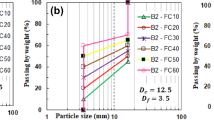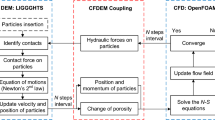Abstract
Collapsing soil structure caused by mineral dissolution is a challenge to geoenvironmental projects. Although the parameters affecting the macro-response of collapsible soil have been addressed experimentally, the micromechanical behavior of soluble soil is unclear. The aim of this study was to simulate the dissolution behavior of a granular assembly at the particle level. A DEM code was developed that considers both localized and random dissolution as well as the particle size distribution and stress level. The effect of particle dissolution was simulated by considering the role of particle size in the load-bearing skeleton. The results show that mechanical behavior of a granular assembly is strongly influenced by the location and percentage of dissolution of particles. The loss of the soluble particles decreases physical contact and transfers to neighboring particles due to the arching forces around the voids, as in a honeycomb structure. However, if the soluble areas cut across the load-bearing force chains, a honeycomb fabric cannot form because of the lack of an arching effect, leading to the collapse of the structure and large volume change. Particle loss of up to 3% will not have a serious impact on the mechanical behavior of the granular assembly. After fine particle dissolution of a binary mixture, the arching effect around them decreases the volumetric strain in comparison with the dissolution of coarse particles. Also, during dissolution, the high stress level will decrease the peak friction angle, but the opposite is true for the post-dissolution behavior above 12% strain.


















Similar content being viewed by others
References
Das BM (2015) Principles of foundation engineering. Cengage learning, Boston
Gaaver KE (2012) Geotechnical properties of Egyptian collapsible soils. Alex Eng J 51:205–210
Bell FG (2007) Engineering geology, 2nd edn. Elsevier, London
Gao X-J, Wang J-C, Zhu X-R (2007) Static load test and load transfer mechanism study of squeezed branch and plate pile in collapsible loess foundation. J Zhejiang Univ Sci A 8:1110–1117
Reznik YM (2007) Influence of physical properties on deformation characteristics of collapsible soils. Eng Geol 92:27–37
Truong QH, Eom YH, Lee JS (2010) Stiffness characteristics of soluble mixtures. Geotechnique 60(4):293–297
Waltham T (2009) Foundations of engineering geology, 3rd edn. Spon Press, New York
Barden L, Mcgown A, Collins K (1973) The collapse mechanism in partly saturated soil. Eng Geol 7:49–60
Veni G, Duchene H, Crawford NC, Groves CG, Huppert GN, Kastning EH, Olson R, Wheeler BJ (2001) Living with karst: a fragile foundation. American Geological Institute, Alexandria
Hunt RE (2007) Geologic hazards: a field guide for geotechnical engineers. CRC Press, Boca Raton
Cha M, Santamarina JC (2016) Hydro-chemo-mechanical coupling in sediments: localized mineral dissolution. Geomech Energy Environ 7:1–9
Borja RI (2006) Conditions for instabilities in collapsible solids including volume implosion and compaction banding. Acta Geotech 1:107–122
Mitchell JK, Soga K (2005) Fundamentals of soil behavior. Willy, New York, p 592
Fattah MY, Al-Ani MM, Al-Lamy MT (2014) Studying collapse potential of gypseous soil treated by grouting. Soils Found 54:396–404
Fattah MY, Al-Ani MM, Al-Lamy MTA (2015) Wetting and drying collapse behaviour of collapsible gypseous soils treated by grouting. Arab J Geosci 8(4):2035–2049
Fattah MY, Al-Ani MM, Al-Lamy MTA (2013) Treatment of collapse of gypseous soils by grouting. In: Proceedings of the institution of civil engineers, ground improvement journal, UK, vol. 166, no GI1, pp 32–43. https://doi.org/10.1680/grim.11.00020
Al-Damluji S, Al-Farouk O, Al-Obaidi ALM, Al-Omari RR, Al-Ani MM, Fattah MY (2009) Experimental and numerical investigations of dissolution of gypsum in gypsiferrous iraqi soils. In: Proceedings of the 17th international conference on soil mechanics and geotechnical engineering, Alexandria, Egypt, 5–9 Oct 2009, vol 1, pp 820–824
Lee J-S, Tran MK, Lee C (2012) Evolution of layered physical properties in soluble mixture: experimental and numerical approaches. Eng Geol 143:37–42
Shin H, Santamarina JC (2009) Mineral dissolution and the evolution of k0. J Geotech Geoenviron Eng 135(8):1141–1147
Shin H, Santamarina JC, Cartwright JA (2008) Contraction-driven shear failure in compacting uncemented sediments. Geology 36(12):931–934
Fam MA, Cascante G, Dusseault MB (2002) Large and small strain properties of sands subjected to local void increase. J Geotech Geoenviron Eng 128(12):1018–1025
Cha M, Santamarina JC (2013) Predissolution and post dissolution penetration resistance. J Geotech Geoenviron Eng 139(12):2193–2200
Mcdougall J, Kelly D, Barreto D (2013) Particle loss and volume change on dissolution: experimental results and analysis of particle size and amount effects. Acta Geotech 8(6):619–627
Simpson B, Tatsuoka F (2008) Geotechnics: the next 60 years. The essence of geotechnical engineering: 60 years of géotechnique. Thomas Telford Publishing, London
Cha M, Santamarina JC (2014) Dissolution of randomly distributed soluble grains: post-dissolution k0-loading and shear. Geotechnique 64(10):828–836
Cundall PA, Strack OD (1979) A discrete numerical model for granular assemblies. Geotechnique 29:47–65
Zhu H, Zhou Z, Yang R, Yu A (2007) Discrete particle simulation of particulate systems: theoretical developments. Chem Eng Sci 62:3378–3396
Coetzee CJ (2014) Discrete and continuum modelling of soil cutting. Comput Part Mech 1:409–423
Zdravkovic L, Carter J (2008) Constitutive and numerical modelling. Geotechnique 58:405
Zhu H, Zhou Z, Yang R, Yu A (2008) Discrete particle simulation of particulate systems: a review of major applications and findings. Chem Eng Sci 63:5728–5770
Bayesteh H, Mirghasemi A (2015) Numerical simulation of porosity and tortuosity effect on the permeability in clay: microstructural approach. Soils Found 55:1158–1170
Zárate F, Cornejo A, Oñate E (2018) A three-dimensional FEM–DEM technique for predicting the evolution of fracture in geomaterials and concrete. Comput Part Mech 5:411–420
Esposito RG, Velloso RQ Jr, Danziger EAV (2018) Multi-scale sensitivity analysis of pile installation using DEM. Comput Part Mech 5:375–386
Huang X, O’Sullivan C, Hanley KJ, Kwok CY (2017) Partition of the contact force network obtained in discrete element simulations of element tests. Comput Part Mech 4:145–152
Bandeira AA, Zohdi TI (2018) 3D numerical simulations of granular materials using DEM models considering rolling phenomena. Comput Part Mech. https://doi.org/10.1007/s40571-018-0200-0
Liu S, Sun D, Wang Y (2003) Numerical study of soil collapse behavior by discrete element modelling. Comput Geotech 30:399–408
Tran M, Shin H, Byun YH, Lee S (2012) Mineral dissolution effects on mechanical strength. Eng Geol 125:26–34
Mirghasemi A, Rothenburg L, Matyas E (1997) Numerical simulations of assemblies of two-dimensional polygon-shaped particles and effects of confining pressure on shear strength. Soils Found 37:43–52
Bayesteh H, Mirghasemi A (2013) Procedure to detect the contact of platy cohesive particles in discrete element analysis. Powder Technol 244:75–84
Seyedi Hosseininia E (2012) Discrete element modeling of inherently anisotropic granular assemblies with polygonal particles. Particuology 10(2012):542–552
Seyedi Hosseininia E (2012) Investigating the micromechanical evolutions within inherently anisotropic granular materials using discrete element method. Granul Matter 2012(14):483–503
Abedi S, Mirghasemi AA (2011) Particle shape consideration in numerical simulation of assemblies of irregularly shaped particles. Particuology 9(2011):387–397
Rothenburg L, Bathurst RJ (1989) Analytical study of induced anisotropy in idealized granular materials. Géotechnique 39(4):601–614
Seyedi Hosseininia E, Mirghasemi AA (2006) Numerical simulation of breakage of two-dimensional polygon-shaped particles using discrete element method. Powder Technol 166:100–112
Shire T, O’sullivan C, Hanley K (2016) The influence of fines content and size-ratio on the micro-scale properties of dense bimodal materials. Granul Matter 18:1–10
Huang X, O’Sullivan C, Hanley KJ, Kwok CY (2014) Discrete-element method analysis of the state parameter. Geotechnique 64(12):954–965
Shire T, O’sullivan C (2016) Constriction size distributions of granular filters: a numerical study. Geotechnique 64(10):826–839
Yang J, Luo XD (2017) The critical state friction angle of granular materials: Does it depend on grading? Acta Geotech 13(3):535–547
Vahidi-Nia F, Lashkari A, Binesh SM (2015) An insight into the mechanical behavior of binary granular soils. Particuology 21:82–89
Dorostkar O, Mirghasemi AA (2016) Micro-mechanical study of stress path and initial conditions in granular materials using DEM. Comput Part Mech 3:15–27
Acknowledgements
This study was supported by the Iran National Science Foundation (INSF) under Grant No. 96008954. This support is greatly appreciated.
Author information
Authors and Affiliations
Corresponding author
Rights and permissions
About this article
Cite this article
Bayesteh, H., Ghasempour, T. Role of the location and size of soluble particles in the mechanical behavior of collapsible granular soil: a DEM simulation. Comp. Part. Mech. 6, 327–341 (2019). https://doi.org/10.1007/s40571-018-00216-x
Received:
Revised:
Accepted:
Published:
Issue Date:
DOI: https://doi.org/10.1007/s40571-018-00216-x




